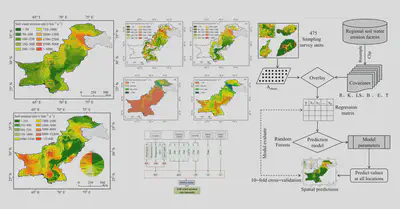Abstract
Soil erosion triggered by water and wind pose a great threat to the sustainable development of Pakistan. In this study, a combination of geographic information systems (GISs) and machine learning approaches were used to predict soil water erosion rates. The Revised Wind Erosion Equation (RWEQ) model was used to evaluate soil wind erosion, map erosion factors, and analyze the soil erosion rates for each land use type. Finally, the maps of soil water and wind erosion were spatially integrated to identify erosion risk regions and recommend land use management in Pakistan. According to our estimates, the Potohar Plateau and its surrounding regions were mostly impacted by water erosion and have a soil erosion rate of 2500–5000 t·km−2·a−1; on the other hand, wind erosion predominated the Kharan Desert and the Thar Desert, with a soil erosion rate exceeding 15,000 t·km−2·a−1. The Sulaiman and Kirthar Mountain Ranges were susceptible to wind–water compound erosion, which was more than 8000 t·km−2·a−1. This study offers new perspectives on the geographic pattern of individual and integrated water–wind erosion threats in Pakistan and provides high-precision data and a scientific foundation for designing rational soil and water conservation practices.
